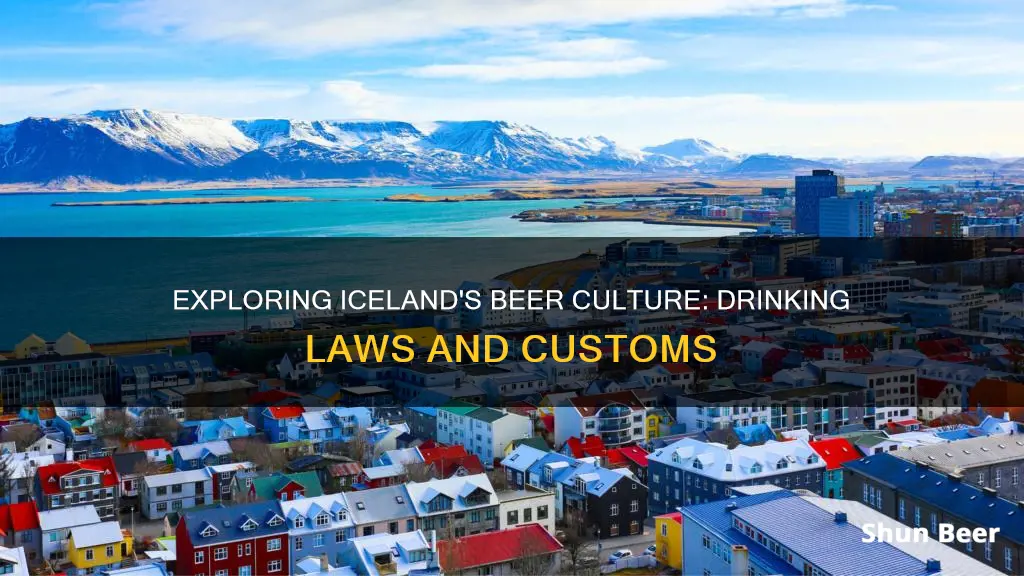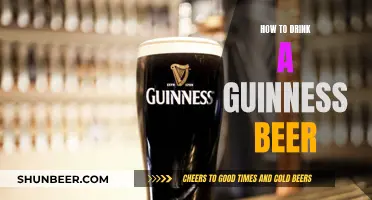
Iceland's relationship with alcohol has been a complicated one. The nation instituted a total prohibition on all alcoholic drinks in 1915, which lasted to some extent until 1989. Beer, in particular, was singled out and remained banned until 1 March 1989, when the temperature outside was a chilly -5°C. So, what's the story behind this 74-year ban on beer?
What You'll Learn

Iceland banned beer for nearly a century
The association between alcohol and Denmark was a key factor in the original prohibition. Iceland was seeking independence from Denmark at the time, and Icelanders strongly associated beer with Danish lifestyles. Danes drank eight times as much alcohol per person as Icelanders. As a result, beer was seen as "not the patriotic drink of choice". The independence and temperance movements reinforced each other, and prohibition was seen as progressive.
In 1908, four years after gaining home rule, Iceland held a referendum on a proposal to ban all alcohol from 1915. About 60% voted in favour, including many women, who did not yet have the vote. However, the ban was soon undermined by smuggling, home-brewing, and lobbying by ambassadors. Doctors also started prescribing alcohol as medicine for a variety of ailments.
In 1921, the ban was partially lifted after Spain refused to buy Iceland's main export, fish, unless Iceland bought Spanish wines. However, the ban on beer remained in place, due to concerns that it would lead to a rise in alcohol abuse. Beer was cheaper than wine or spirits, and the temperance lobby argued that it would lead to more depravity.
In the 1970s, international travel brought Icelanders back in touch with beer, and bills to legalise it were regularly proposed in parliament. In 1979, a businessman challenged the rule that only pilots, cabin crew, and foreign tourists could bring in duty-free beer. When his six bottles were confiscated, he refused to pay the fine, and the resulting cause was taken up by an MP, whose bill to allow Icelanders the same rights was passed in 1980.
Finally, in 1988, after televised debates and a midnight vote, Iceland's parliament voted to legalise beer. On 1 March 1989, Icelanders were able to buy beer in the country for the first time in 74 years. This day is now celebrated annually as Beer Day, or Bjordagur.
Cialis and Beer: A Safe Mix?
You may want to see also

Beer was banned for political reasons
Beer was banned in Iceland for 74 years, from 1915 until 1 March 1989. While the prohibition initially banned all alcoholic drinks, wine was legalised within a decade, followed by spirits in the 1930s. However, full-strength beer remained prohibited until the end of the century.
The ban on beer in Iceland was largely due to political reasons. During the early 20th century, Iceland was fighting for independence from Denmark. Icelanders strongly associated beer with Danish lifestyles, as the Danes were drinking eight times as much alcohol per person annually. Beer was seen as "not the patriotic drink of choice". The independence and temperance movements reinforced each other, and the push for prohibition was seen as a way to reject the hard-drinking colonial rule of the Danes.
In 1908, four years after gaining home rule, Iceland held a referendum on a proposal to ban all alcohol from 1915. About 60% of voters, including women who did not yet have the right to vote, supported the prohibition. The movement was seen as progressive, similar to how smoking bans are viewed today.
Despite the ban, Icelanders found ways to access and consume alcohol. Smuggling and home-brewing were common, and doctors even started prescribing alcohol as medicine for various ailments. In 1921, the ban was partially lifted when Spain threatened to stop importing Iceland's main export, fish, unless Iceland bought Spanish wines. However, the legalisation only applied to wine and spirits, while beer remained prohibited.
It wasn't until the 1970s and 1980s that attitudes towards beer began to shift. Icelanders were travelling internationally and experiencing the drinking cultures of other countries, including the popularity of pubs in cities like London. In 1979, a businessman named David Scheving Thorsteinsson challenged the rule that only allowed pilots, cabin crew, and foreign tourists to bring in duty-free beer. Although his six bottles were confiscated, his cause gained support, and in 1980, Icelanders were allowed to buy beer from the duty-free shop at Keflavik airport. Finally, in 1988, after televised debates and a midnight vote, Iceland's parliament legalised beer, ending the 74-year ban.
Beer and Football: Ohio State's Game-Day Drinking Policy
You may want to see also

Icelanders associated beer with Danish lifestyles
Iceland's association of beer with Danish lifestyles is rooted in its history of seeking independence from Denmark. In the early 20th century, as Iceland was striving for independence, a temperance movement emerged, pushing for a ban on alcohol, including beer. This movement was influenced by the political climate of the time, as Icelanders associated beer with Danish culture and lifestyles.
At the time, Denmark was Iceland's colonial overlord, and the Danish people consumed significantly more alcohol per person than Icelanders. As a result, beer was seen as "not the patriotic drink of choice" in Iceland. This sentiment was so strong that when full prohibition became law in 1915, beer remained off-limits even after other alcoholic beverages, like wine and spirits, were legalised.
The association between beer and Denmark continued to tarnish the image of beer in Iceland, even after achieving full independence in 1944. It wasn't until the rise of international travel and city break holidays in the 1970s that Icelandic attitudes towards beer began to shift. Icelanders started to visit places like London, where they could enjoy British pubs and beer, and they wanted to bring this experience back to their home country.
Finally, on March 1, 1989, after decades of prohibition, Icelanders were once again legally allowed to drink beer. This day is now celebrated annually as Bjordagur (Beer Day) in Iceland.
Exploring the Limits: 50 IPAs, a Safe Challenge?
You may want to see also

Beer was legalised in 1989
Beer was finally legalised in Iceland on 1 March 1989, bringing to an end a 74-year prohibition. The ban on beer was lifted when the upper house of Iceland's parliament, the Althing, voted 13-8 in favour of legalisation following a series of televised debates. The vote took place at midnight, and revellers flashed victory signs outside the parliament building.
The day is now celebrated annually as Bjordagur (Beer Day), though it tends to be a much more subdued affair than the bacchanalian scenes of 1989. On Beer Day, some people take part in a "rúntur" (bar crawl), with certain bars staying open until 4:00 a.m. the next day.
Beer was banned in Iceland for longer than in any other country. The prohibition dated back to 1915, when a referendum voted in favour of a total ban on alcoholic drinks. Wine was legalised in 1921/1922, and spirits in 1933/1935, but beer remained off-limits. This was partly due to its association with Denmark, which had ruled Iceland until 1944. Beer was also seen as a cause of loutish, anti-social behaviour and casual drinking.
In the years before the ban was lifted, Icelanders who wanted beer drank bjorlíki, a vodka-pilsner cocktail, or added spirits to non-alcoholic beer. From 1979, Icelanders could buy beer from the duty-free shop at Keflavik airport.
Beer is now the most popular alcoholic drink in Iceland, accounting for 62% of the 7.1 litres of pure alcohol consumed each year by the average Icelander.
How Long Does Beer Last Once Opened?
You may want to see also

Beer is now Iceland's most popular alcoholic beverage
During the prohibition years, Icelanders had to be creative in their drinking habits. Bars served bjorlíki, a vodka-pilsner cocktail that resembled beer. It was also common to mix brennivin (a potato-based vodka, also known as "Black Death") with non-alcoholic beer, resulting in a drink that was "interesting and totally disgusting", according to one source.
The movement towards legalising beer gained momentum in the 1970s, as international travel brought Icelanders back in touch with the beverage. Finally, in 1988, after televised debates and a midnight vote, beer was permanently legalised.
Today, Iceland has a thriving craft beer culture, with new labels and microbreweries emerging all the time. Popular breweries include Einstök, Bruggsmiðjan, and Borg Brugghús, each offering a range of unique and delicious beers. Icelanders now consume more beer per capita than traditional brewing countries such as Germany and the Czech Republic.
The legalisation of beer in Iceland is a fascinating example of how cultural and political factors can influence drinking habits and shape a nation's relationship with alcohol.
Beer Drinking: Healthy Habit or Health Hazard?
You may want to see also
Frequently asked questions
Yes, you can. Beer was banned in Iceland from 1915 until 1 March 1989.
The ban was part of a complete prohibition throughout the country. Wine and spirits were decriminalised within two decades, but beer took much longer to become legal again because it was believed to encourage loutish, anti-social behaviour and casual drinking. Beer was also associated with Danish lifestyles at a time when Iceland was fighting for independence from Denmark.
Beer Day is celebrated annually on 1 March. People might go on a "rúntur" (bar crawl), with some bars staying open until 4:00 a.m. the next day.







